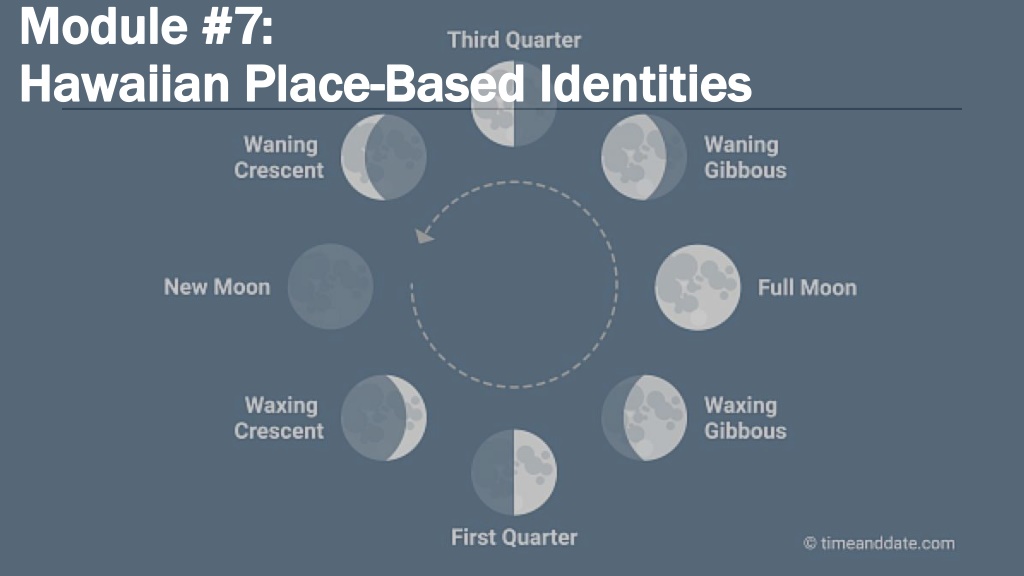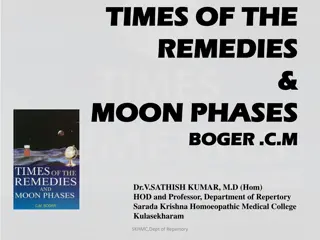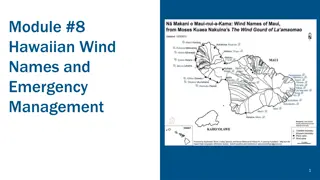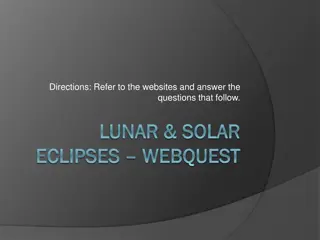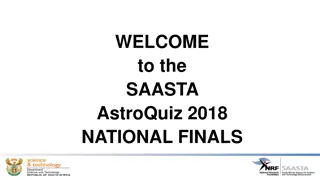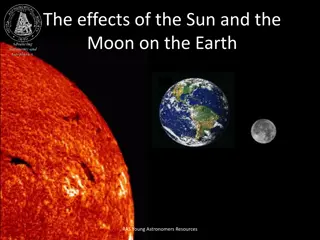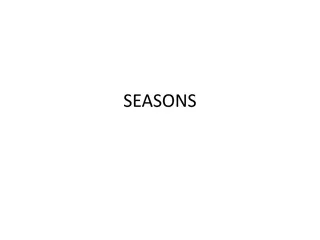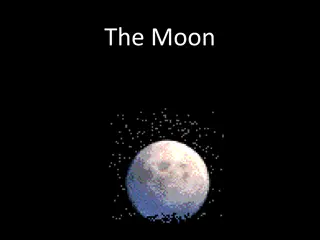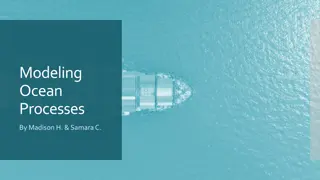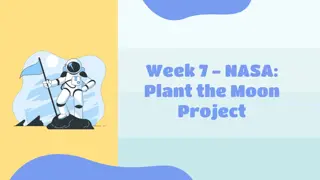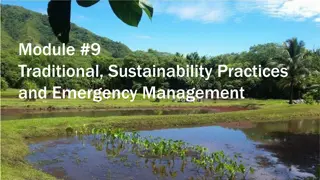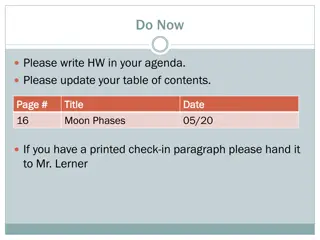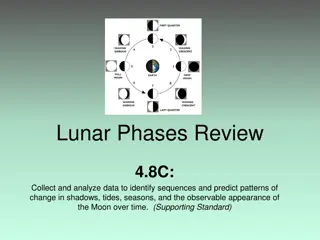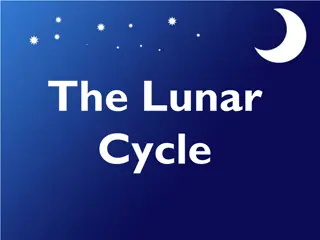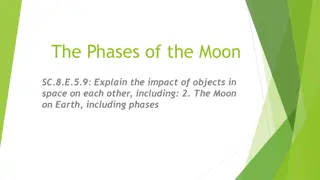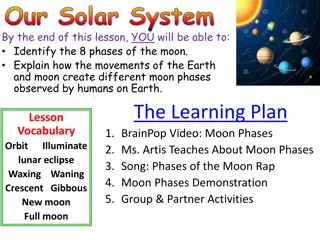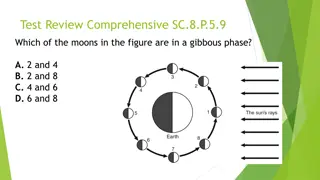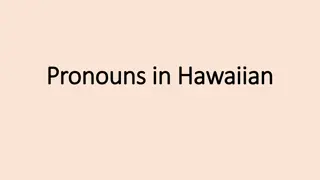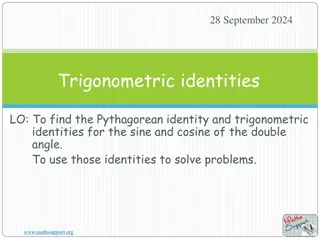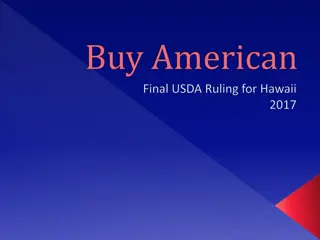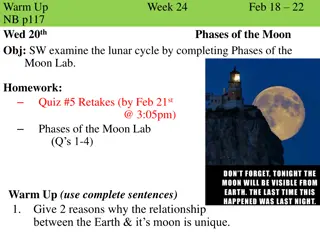Understanding Hawaiian Place-Based Identities and Moon Phases
Explore the profound connection between Hawaiian place-based identities and the phases of the moon, uncovering traditional practices, weather disturbances, and emergency management planning rooted in ancestral knowledge and oral culture.
Download Presentation

Please find below an Image/Link to download the presentation.
The content on the website is provided AS IS for your information and personal use only. It may not be sold, licensed, or shared on other websites without obtaining consent from the author. Download presentation by click this link. If you encounter any issues during the download, it is possible that the publisher has removed the file from their server.
E N D
Presentation Transcript
Module #7: Module #7: Hawaiian Place Hawaiian Place- -Based Identities Based Identities
Learning Objectives To understand the connection between people and the elements of reference, i.e., the Moon Phases. To understand the solar system with the different phases of the moon. To connect the different moon phases with weather disturbances, traditional practices, and people To develop an understanding of an oral culture through ancestral knowledge. 2
Driving Questions How do place-based identities connect to climate change? How does knowledge of the moon phases connect to climate change? How does the knowledge of moon phases connect to emergency management planning? 3
Module Sections Cultural protocol Introductions Activity The Moon Phases Storytelling: Mo olelo of Hina Moon phases Days 1-30 King Tides Case study #1:N P O Ka Malama: The Nights of the Hawaiian Month Mosaic Art Reflection & Creative Theater activity Case study #2: How King Tides became Hawaii s Climate Change Wake-up Call Reflection for class 4
Cultural Protocol Elder and/or leader to start beginning protocol to have everyone on the same page. Words to E H Mai (By: Edith Kanaka ole Kanahele) E h mai ka ike mai luna mai O n mea huna no eau o n mele E h mai, e h mai, e h mai (x3) 5
Introductions Each person introduces themself and where they are from in the Hawaiian language. Each person explains what connects them to this place. Follow below: Aloha. O (first & last name) ko u inoa. No (place of residence) mai au. What makes me pili to Hawaii? 6
Mo Mo olelo olelo of of Hina Hina There are many stories about the goddess Hina. She is often connected with the moon and is mostly described as a very smart and attractive woman often pursued by men and other creatures. In Hawaiian mo olelo (stories) and chants, there are variations on her name such as Hina-puki-i a (Hina gathering seafood) a goddess of fishermen and Hina- opu-hala-ko a who gave birth to all reef life. But one of the most well-traveled stories speaks of this beautiful yet determined woman who becomes tired of being on earth and flees to the moon, eventually becoming the goddess of it. 7
Anahulu Anahulu Ho Ho onui onui The following slides have Days 1-10 of the month with their respective names Anahulu = A period of ten days Ho onui = Rising 8
Anahulu Hoonui: Beginning of the Moon Phases Day 1: Moon phase is called Hilo. Low to the horizon in the West at sunset. Fishing: on the shoreline. Farming: is unproductive. Day 2: Moon phase is called Hoaka. In the West at sunset. Good fishing in lagoon, bay, and deep sea. Good planting, i.e. ulu, uala, kalo, mai a, & k . 9
Anahulu Hoonui: K Moon Phases Day 3: Moon phase is called Day 3: Moon phase is called K kahi K kahi Day 5: Moon phase is called Day 5: Moon phase is called K kolu K kolu Visible in early evening. Visible in day. Excellent fishing in lagoon, bay, and deep sea. Good fishing in canoe and beach. Collect wana and limu. Good farming, i.e. for uala, kalo, & mai a. Good planting, i.e. uala, kalo, & mai a. Day 4: Moon phase is called Day 4: Moon phase is called K lua K lua Day 6: Moon phase is called Day 6: Moon phase is called K pau K pau Visible through evening. Visible through late evening. Excellent fishing in lagoon, bay, and deep sea. Good fishing in lagoon, bay, and offshore. Good planting, i.e. uala, kalo, & mai a. Good planting, i.e. uala, kalo, & mai a. 10
Anahulu Hoonui: Ole Moon Phases Day 7: Moon phase called Day 7: Moon phase called olek kahi olek kahi Day 9: Moon phase called Day 9: Moon phase called olek kolu olek kolu Visible until middle of night. Time to rest and prepare. Visible until after midnight. A time to rest and prepare. Poor fishing. Poor fishing. Unproductive planting, time for maintenance. Unproductive farming. Day 8: Moon phase called Day 8: Moon phase called olek lua olek lua Day 10: Moon phase called Day 10: Moon phase called olepau olepau Visible until after midnight. Visible until after midnight. Poor fishing. Poor fishing. Unproductive planting. Unproductive planting. 11
Anahulu Anahulu Poepoe Poepoe The following slides have Days 11-20 of the month with their respective names Anahulu = A period of ten days Poepoe = Full 12
Anahulu Poepoe Day 11: Day 11: Huna Huna Day 13: Day 13: Hua Hua: Sacred night to : Sacred night to K ne K ne and and Lono Lono Visible until after midnight. Visible until near dawn. Good fishing. Good fishing. Good planting rooted plants such as ipu. Excellent planting. Day 12: Day 12: Mohalu Mohalu: Sacred night to : Sacred night to K ne K ne Visible until before dawn. Good night for fishing. Excellent planting flowering plants, ipu, uala, & kalo. 13
Anahulu Poepoe: Full Moons Day 14: Day 14: Akua Akua: 1 of 3 full moons. : 1 of 3 full moons. Day 16: Day 16: M healani M healani: 3 of 3 full moons. : 3 of 3 full moons. Sacred to K ne and Lono. Visible until early morning. Visible throughout night. Excellent fishing. Good fishing. Excellent planting, ex: uala, kalo, mai a, & fruit plants. Excellent planting. Day 15: Day 15: Hoku Visible throughout night. Hoku: 2 of 3 full moons. : 2 of 3 full moons. Good fishing. Excellent planting, ex: mai a & root plants. 14
Anahulu Poepoe Day 17: Day 17: K lua twilight twilight K lua: First moon to rise after : First moon to rise after Day 19: Day 19: L L auk lua auk lua: 2 of 3 : 2 of 3 l l au au moons moons Visible until mid morning. Visible until early morning. Descent fishing. Good fishing. Collect plants for medicinal use. Plant mai a & trees. Good planting. Day 18: Day 18: L L auk kahi auk kahi: 1 of 3 : 1 of 3 l l au au moons moons Day 20: Day 20: L L aupau aupau: 3 of 3 : 3 of 3 l l au au moons moons L au refers to medicine, wood, & plant life. Visible until late morning. Descent fishing. Descent fishing. Collect plants for medicinal use. Plant mai a & trees. Collect plants for medicinal use. Plant mai a & trees. 15
Anahulu Anahulu Emi Emi The following slides have Days 21-30 of the month with their respective names Anahulu = A period of ten days Emi = Falling 16
Anahulu Anahulu Emi Emi Day 23: Day 23: Olepau Time of rest & preparation. Time of rest & preparation. Visible after midnight until afternoon. Olepau: 3 of 3 : 3 of 3 ole ole moons. moons. Day 21: Day 21: Olek kahi Olek kahi: 1 of 3 Time of rest & preparation. Time of rest & preparation. Visible late night until around noon. : 1 of 3 ole ole moons. moons. Unproductive fishing & planting. Unproductive fishing & planting. Preparation day. Preparation day. Day 22: Day 22: Olek lua Time of rest & preparation. Time of rest & preparation. Visible after midnight until mid day. Olek lua: 2 of 3 : 2 of 3 ole ole moons. moons. Unproductive fishing & planting. Preparation day. 17
Anahulu Anahulu Emi Emi Day 24: Day 24: K loak kahi K loak kahi: 1 of 3 Kanaloa Kanaloa honored. honored. k loa good fishing. good fishing. Best viewing at sunrise. : 1 of 3 k loa k loa moons known for moons known for k loa moons. moons. Day 26: Day 26: K loapau K loapau: 3 of 3 : 3 of 3 k loa k loa moons. moons. Best viewing to the east at sunrise. Good fishing. Good fishing in lagoon & offshore. Descent planting, ex: k & ohe. Good planting, ex: k , wauke, hala, mai a, & ohe. Day 25: Day 25: K loak lua K loak lua: 2 of 3 K loa moons known for good fishing. : 2 of 3 k loa k loa moons. moons. Good fishing in lagoon & offshore. Good planting, ex: k , wauke, hala, mai a, & ohe. 18
Anahulu Emi Day 29: Day 29: Mauli Mauli Day 27: Day 27: K ne for life. for life. K ne: A time of prayer & gratitude : A time of prayer & gratitude Rarely visible Viewing to the east at dawn. Best viewing to the east at sunrise. Good fishing. No fishing & planting. Excellent for planting dark green vegetables. Day 28: Day 28: Lono for life. for life. Lono: A time of prayer & gratitude : A time of prayer & gratitude Day 30: Day 30: Muku Muku: Rises with the sun. : Rises with the sun. Best viewing to the east at sunrise. Not visible. No fishing & planting. Good fishing to collect wana & limu. Good planting, ex: mai a & k . 19
King Tides ( King Tides (Perigean Perigean Spring Tide) Spring Tide) King Tides: Highest astronomical tides during the summer & winter months. This event occurs: When the moon is closest to the Earth in its monthly orbit during the new moon. When the sun, moon, & Earth are in alignment during the full moon. Both events create a strong gravitational pull. This dynamic means that the sun and moon s Individual gravitational pulls work together, producing the highest high tides of the year, or the King Tides. 20
King Tides & Full Moons Occurring Simultaneously When King tides occur at the same time as the moon phases of Akua, Hoku, & Mahealani, extreme levels of sea level rise occur. This phenomena allows for communities to know when they need to do the following: Prepare for shoreline flooding in low lying areas. Will know before hand that this phenomena will occur based on ike Hawai i (Hawaiian knowledge). Prepare for emergency management if home and business is along the shoreline. Prepare for family to stay at home and/or relocate to safe area ahead of time instead of in an emergency situation. Federal Emergency Management Agency 21
Case Study #1 Case Study #1 Read Langlas, Charles M. N P O Ka Malama: The Nights of the Hawaiian Month. Palapala, 1: 2017. 101-112. Discuss as a group: Four opinions regarding p . Primary Hawaiian language sources. Secondary sources & Tsuha s Master s thesis proposal. Polynesian comparisons. 22
Group Activity: Group Activity: Mosaic Art Reflection & Creative Theater Get together in groups of 4 or 5 Discuss 5 important dynamics to know about place-based identities and the connection to climate change. Each person will draw on a 5 inch x 5 inch canvas a picture that represents their vision of how place-based identity can help in disaster and/or emergency plans. Each group will create a mo olelo (story) as to how they will create a plan for emergency management by using place-based management. Each group will act out their vision. 23
Group Activity: Group Activity: End Product Ike Ku una Art Reflection 6x2ft poster board. Each student will be given a square to draw and color their own reflection. All squares will be joined together to form a Mosaic Art piece at the end of the specific curriculum. The Mosaic Art Reflection will be a visual board of the "self-reflection" that includes reactions from the driving question, mo olelo, hana, loina/lawena, importance of ike ku una, understanding ike hawai i. 24
Case Study #2 Case Study #2 Read: Tucker, Keahi. 2017 in Review: How King Tides became Hawaii s Climate Change Wake-up Call. Hawaii News Now. December 27, 2017. Discuss as a group: What are the main ideas from this article? What is missing from this dialogue? What would you add to this dialogue? 25
Reflection For All Reflection For All Gather together to share Connect different worldviews What will you take-away from this curriculum? Will you incorporate an Indigenous worldview for future practices? How can your organization use this type of culture-based curriculum? 26
Oli Mahalo Thank Thank you you chant chant in Hawaiian Language: in Hawaiian Language: English Translation: English Translation: Uhola ia ka makaloa l P ai i ke aloha l K ka i ia ka h loa l P wehi mai n lehua Mai ka ho oku i a ka h l wail Mahalo e Ke Akua* Mahalo e n kupuna l e Mahalo me ke aloha l Mahalo me ke aloha l The makaloa mat has been unfolded Food is shared in love The great breath is exchanged The Lehua honors and adores From zenith to horizon Gratitude to God Gratitude to our ancestors Gratitude with love Gratitude with love 27
References: References: Ke K o Makali i (The Canoe-Bailer of Makali i). Webpage at: archive.hokulea.com/ike/hookele/hawaiian_star_lines. Last seen December 09, 2018. Kilselka, Will. Polynesian Stars and Men: The Puzzle of the Ancient Navigation of the Polynesians. Bishop Museum Science Center. Honolulu, HI. 1969. Makemson, Maud W. American Anthropologist. New Series. Journal Article, Vol. 40, No.3. 1938. 370-383. Papak Makawalu (Kanahele, P. K., Kanahele-Mossman, H., Nuuhiwa, K., and Kanahele, K. H.). (2011). Mahina. Hilo, HI: Edith K. Kanaka ole Foundation. Retrieved from http://edithkanakaolefoundation.org/wp- content/uploads/2012/06/Mahina_BookDigital_v2.pdf. 28
